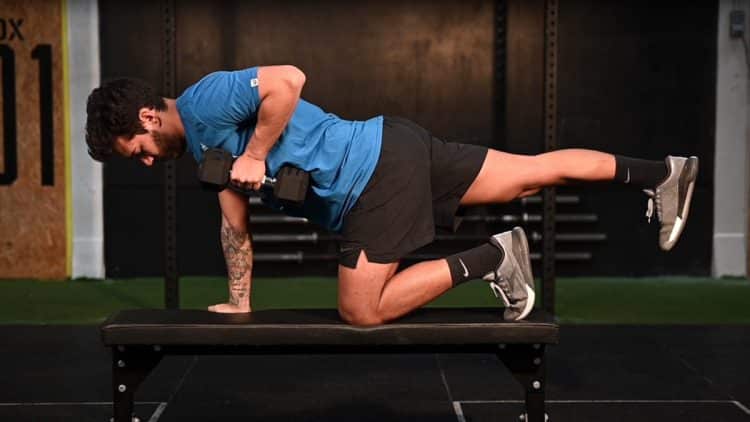Sit-ups are one of the most popular ab exercises. For most people, ab workouts are synonymous with sit-ups. You, too, have probably seen countless people performing them at the gym.
In my experience as a personal trainer, I’ve found that sit-ups are not the most effective abdomen exercise.
Plus, the biomechanics of this exercise can put undue strain on the spine and neck, which can cause long-term damage. Due to its limited muscle activation, this exercise does little to boost core strength.
My clients have experienced immensely better improvements in posture, athletic performance, and overall functionality by replacing sit-ups with functional core exercises.
In this article, I pull back the curtain on the drawbacks of sit-ups and share the most effective sit-up alternatives for building a stronger core and carving that coveted six-pack.
Why Sit-Ups Are Not the Best Ab Exercise
All those social media fitness influencers will have you believe that sit-ups are non-negotiable for building a chiseled six-pack. However, this is far from the truth. In fact, you could be doing more harm than good by keeping this exercise in your training routine.
Level Up Your Fitness: Join our 💪 strong community in Fitness Volt Newsletter. Get daily inspiration, expert-backed workouts, nutrition tips, the latest in strength sports, and the support you need to reach your goals. Subscribe for free!
These are the four reasons why sit-ups are not the best use of your training time:
Biomechanics Breakdown
Many experts believe that sit-ups primarily engage the hip flexors, not the core muscles. Hip flexors are located at the front of the upper thighs, near the top of the hip. These muscles are responsible for bringing your legs toward your torso and dominate the movement during a sit-up.
Many people feel soreness in this area after doing a higher number of sit-ups.
This doesn’t mean your abdominal muscles play zero role during this exercise. However, they are mainly responsible for stabilizing the spine and controlling the movement. This is one of the biggest reasons I have my clients focus on the eccentrics if they are hell-bent on performing this exercise. (1)
Check Out: How To Perform Sit-Ups
Spinal Stress
Sit-ups involve a weird movement. Think about it; your back is rounded throughout the ROM, putting significant strain on your spine. Each sit-up essentially involves compressing your spinal discs.
While this might not be a big deal for most people, repetitive spinal disc compression can lead to pain, discomfort, and injury for folks with pre-existing back issues.
Sit-ups should be a big no if you’re already dealing with back problems.
Limited Functional Application
Sit-ups are not the most functional exercise. After all, how many times in a day do you find yourself sitting up from a lying position? Things might be different for you if you are The Undertaker, but usually, it’s once or twice when you have to get out of bed.
Instead, I recommend exercises that work your core from different angles to help improve your overall functionality. If you are not a fan of dedicated ab workouts, prioritize lifting heavy weights, playing sports, or maintaining a good posture throughout the day.
The Myth of Spot Reduction
I’m not going to lie; sit-ups are one of the best exercises to isolate the rectus abdominis muscles, resulting in muscle-ripping pumps. This is the main reason most people have this exercise as a part of their training routine.
However, some people confuse muscle isolation with spot reduction. They believe that ab exercises like sit-ups can help them shed belly fat. Sadly, this is not the case. (2)
Losing weight and body fat is mainly a function of running a calorie deficit, meaning you must expend more calories daily than you consume.
Exercises like sit-ups and the other movements listed in this article mainly stimulate the abdomen muscles, which can help you carve a more aesthetically appealing midline. Nothing more, nothing less.
Superior Alternatives to Sit-Ups For Core Training
I believe people who mainly stick to sit-ups in their ab training routine are short-changing themselves. Instead, these are the exercises that should be a part of your training arsenal:
Planks
A weak core can hamper your workout performance and day-to-day functioning. Planks are a static ab exercise that biases the abs, obliques, and glutes and helps boost core stability and endurance. Isometric exercises are excellent for people dealing with joint issues. Since this exercise doesn’t involve movement, it is a potent tool for people undergoing rehabilitation.
How To Perform Planks:
- Kneel on the floor.
- Place your elbows under your shoulders so your forearms are parallel.
- Extend your legs behind you so your body is in a straight line.
- Brace your core as hard as possible.
- Hold this position for the specified time.
Coach Tip: You can choose from many plank variations, depending on your goals. For instance, the side plank, high plank, and reverse plank.
Level Up Your Fitness: Join our 💪 strong community in Fitness Volt Newsletter. Get daily inspiration, expert-backed workouts, nutrition tips, the latest in strength sports, and the support you need to reach your goals. Subscribe for free!
Leg Raises
Sit-ups do little to nothing for the lower abs, which is a lagging muscle group for most people. You must train your abs from all angles to ensure overall development. This is where leg raises shine.
I recommend performing this exercise on an elevated surface, like a flat bench, for an extended ROM.
How To Perform Leg Raises:
- Lie supine on a flat bench with your hips over its edge.
- Place your hands under your hips or lower back for leverage. Your body should be in a straight line in the starting position.
- Slowly lower your heels towards the floor.
- Contract your abs and lift your feet as high towards the ceiling as possible.
- Repeat for recommended repetitions.
Coach Tip: Employ slow, controlled eccentrics to increase the time under tension (TUT) and maximize muscle fiber stimulation and growth.
Reverse Crunches
Surprised to see a crunch variation on this list? Don’t be.
Reverse crunches are the mirror opposite of sit-ups, as they involve moving the lower body and don’t strain the spine. This unassuming exercise will leave you with a sick ab pump every single time.
How To Do Reverse Crunches:
- Lie on the floor with your legs extended and arms at your sides.
- Place your hands under your hips.
- Contract your abs, flex your knees, and bring them to your chest.
- Your thighs should touch your abs at the top of your ROM.
- Pause briefly in the fully shortened position.
- Slowly return to the starting position.
Coach Tip: As you gain more experience, wear ankle weights to make this exercise more challenging.
Anti-Rotation Exercises
There are just too many effective sit-up alternative exercises to list in this article. Instead, I’ll walk you over the different types of exercises you can do and give you a comprehensive list of movements.
Anti-rotational exercises are transverse plane exercises that enhance core stability by training your muscles to resist twisting and turning forces. Here are some of the exercises that should be a part of your routine:
10 Best Anti-Rotational Sit-Up Alternatives:
- Pallof press
- Russian twists
- Side plank with cable row
- Bird-dog
- Plank with arm reach
- Renegade row
- Landmine anti-rotation press
- Single-arm dumbbell bench press
- Side plank with cable row
- Dead bug
Start with the exercises that you are the most comfortable with. Then, incorporate progressive overload by using additional resistance or limiting the rest time between exercises to challenge your core consistently.

Read also: 12 Best Rotation and Anti-Rotation Exercises for Functional Core Strength
Dynamic Movements
If your primary aim is to lose belly fat and get a diced six-pack, dynamic exercises should be at the top of your list.
These movements will get your heart rate up for increased calorie expenditure. They will also boost your metabolism and result in excess post-exercise oxygen consumption (EPOC), helping you burn calories hours after your workout.
Dynamic exercises generally mimic real-life movements and engage multiple muscle groups.
8 Best Dynamic Movements For Ab Training:
- Mountain climbers
- Bear crawls
- Flutter kicks
- Bicycle crunches
- Standing knee drives
- High knees
- Jumping jacks
- Plank jacks
Coach Tip: Focus on control while performing these exercises. Maintain good form and keep your core engaged throughout the range of motion (ROM) to maximize target muscle stimulation and development.
Sample Core Workout For Best Results
This might break your heart, but you must hear this — sit-ups aren’t the holy grail ab exercise they are made out to be. A few minutes of sit-ups won’t get you washboard abs.
In reality, it might put excessive strain on your spine as you must repeatedly flex your spine during this exercise. Some people report lower back and disc issues down the line due to this exercise.
I used my 17 years of coaching experience to design a super-effective ab training regime. It hits the core from different angles, building optimal strength, stability, and posture. Check it out:
| Exercise | Sets | Reps | Rest (seconds) |
| Plank | 3 | 45-60 sec | 60 |
| Side Plank (each side) | 3 | 45-60 sec | 60 |
| Hanging Leg Raises | 3 | 12-15 | 60 |
| Pallof Press (each side) | 3 | 12-15 | 60 |
| Mountain Climbers | 3 | 45 sec | 60 |
Coach Tip: While performing core exercises, you must focus on your breathing to maximize core muscle activation. Breathe out during the concentric phase and inhale during the lowering phase with each repetition.
Since this is a high-intensity ab workout, warm up your core with a five to 10-minute dynamic stretching routine to prime the target muscles and avoid the risk of muscle cramps. Spending the same time during the cool-down phase can help flush out metabolites from the muscles and boost recovery.
Learn to listen to your body. Stop the workout if something feels weird or uncomfortable. Consult your healthcare provider if you’re experiencing pain, and it doesn’t go away within a few days. Feel free to tweak this exercise routine as per your personal preferences, fitness levels, and training objectives.
Conclusion
Although sit-ups can help you isolate your abs, they are not the most effective exercise for sculpting a Greek god-like six-pack.
The alternate exercises listed in this article, like planks, Palloff press, Russian twists, and mountain climbers, are much more effective for improving your posture, losing weight, and building overall core strength.
If you have read this far, I encourage you to try this holistic ab training routine as a 12-week challenge, and you’ll notice the results for yourself. Like any other fitness program, consistency, discipline, and dedication are key when trying to build a rock-solid midsection that’s ready for anything.
If you have any questions about any of the exercises listed in this article or need help implementing them into your routine, post them in the comments below, and I’ll be happy to help!
References:
- Azevedo PHSM, Oliveira MGD, Schoenfeld BJ. Effect of different eccentric tempos on hypertrophy and strength of the lower limbs. Biol Sport. 2022 Mar;39(2):443-449. doi: 10.5114/biolsport.2022.105335. Epub 2021 Jun 1. PMID: 35309524; PMCID: PMC8919893.
- Kostek, M. A., Pescatello, L. S., Seip, R. L., Angelopoulos, T. J., Clarkson, P. M., Gordon, P. N., Moyna, N. M., Visich, P. S., Zoeller, R. F., Thompson, P. D., Hoffman, E. P., & Price, T. B. (2007). Subcutaneous fat alterations resulting from an upper-body resistance training program. Medicine and science in sports and exercise, 39(7), 1177–1185. https://doi.org/10.1249/mss.0b0138058a5cb









